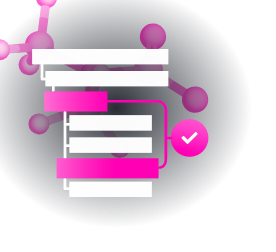Identification
- Generic Name
- PR-104
- DrugBank Accession Number
- DB05968
- Background
-
Not Available
- Type
- Small Molecule
- Groups
- Investigational
- Structure
- Weight
-
Average: 579.27
Monoisotopic: 577.971943 - Chemical Formula
- C14H20BrN4O12PS
- Synonyms
- Not Available
Pharmacology
- Indication
-
Investigated for use/treatment in cancer/tumors (unspecified) and solid tumors.
 Reduce drug development failure ratesBuild, train, & validate machine-learning models
Reduce drug development failure ratesBuild, train, & validate machine-learning models
with evidence-based and structured datasets.Build, train, & validate predictive machine-learning models with structured datasets. - Contraindications & Blackbox Warnings
-
 Avoid life-threatening adverse drug eventsImprove clinical decision support with information oncontraindications & blackbox warnings, population restrictions, harmful risks, & more.Avoid life-threatening adverse drug events & improve clinical decision support.
Avoid life-threatening adverse drug eventsImprove clinical decision support with information oncontraindications & blackbox warnings, population restrictions, harmful risks, & more.Avoid life-threatening adverse drug events & improve clinical decision support. - Pharmacodynamics
-
Not Available
- Mechanism of action
-
PR-104 is a novel hypoxia-activated DNA cross-linking agent with marked activity against human tumor xenografts, both as monotherapy and combined with radiotherapy and chemotherapy. Upon intravenous administration, PR-104 is converted by systemic phosphatases to the alcohol intermediate PR-104A, which is reduced to form the active DNA-crosslinking mustard species hydroxylamine PR-104H intracellularly under hypoxic conditions. PR-104H specifically crosslinks hypoxic tumor cell DNA, resulting in the inhibition of DNA repair and synthesis, cell-cycle arrest, and apoptosis in susceptible hypoxic tumor cell populations while sparing normoxic tissues.
Target Actions Organism UTumor necrosis factor Not Available Humans - Absorption
-
Not Available
- Volume of distribution
-
Not Available
- Protein binding
-
Not Available
- Metabolism
- Not Available
- Route of elimination
-
Not Available
- Half-life
-
Not Available
- Clearance
-
Not Available
- Adverse Effects
-
 Improve decision support & research outcomesWith structured adverse effects data, including:blackbox warnings, adverse reactions, warning & precautions, & incidence rates.Improve decision support & research outcomes with our structured adverse effects data.
Improve decision support & research outcomesWith structured adverse effects data, including:blackbox warnings, adverse reactions, warning & precautions, & incidence rates.Improve decision support & research outcomes with our structured adverse effects data. - Toxicity
-
Not Available
- Pathways
- Not Available
- Pharmacogenomic Effects/ADRsBrowse all" title="" id="snp-actions-info" class="drug-info-popup" href="javascript:void(0);">
- Not Available
Interactions
- Drug InteractionsLearn More" title="" id="structured-interactions-info" class="drug-info-popup" href="javascript:void(0);">
-
This information should not be interpreted without the help of a healthcare provider. If you believe you are experiencing an interaction, contact a healthcare provider immediately. The absence of an interaction does not necessarily mean no interactions exist.Not Available
- Food Interactions
- Not Available
Categories
- Drug Categories
- Classification
- Not classified
- Affected organisms
- Not Available
Chemical Identifiers
- UNII
- V16D2ZT7DT
- CAS number
- 851627-62-8
- InChI Key
- GZSOKPMDWVRVMG-UHFFFAOYSA-N
- InChI
-
InChI=1S/C14H20BrN4O12PS/c1-33(28,29)31-7-5-17(4-2-15)13-11(14(20)16-3-6-30-32(25,26)27)8-10(18(21)22)9-12(13)19(23)24/h8-9H,2-7H2,1H3,(H,16,20)(H2,25,26,27)
- IUPAC Name
-
[2-({2-[(2-bromoethyl)[2-(methanesulfonyloxy)ethyl]amino]-3,5-dinitrophenyl}formamido)ethoxy]phosphonic acid
- SMILES
-
CS(=O)(=O)OCCN(CCBr)C1=C(C=C(C=C1[N+]([O-])=O)[N+]([O-])=O)C(=O)NCCOP(O)(O)=O
References
- 一般引用
-
- Patterson AV, Ferry DM, Edmunds SJ, Gu Y, Singleton RS, Patel K, Pullen SM, Hicks KO, Syddall SP, Atwell GJ, Yang S, Denny WA, Wilson WR: Mechanism of action and preclinical antitumor activity of the novel hypoxia-activated DNA cross-linking agent PR-104. Clin Cancer Res. 2007 Jul 1;13(13):3922-32. [Article]
- External Links
-
- ChemSpider
- 9630821
- ZINC
- ZINC000043131754
- Wikipedia
- PR-104
Clinical Trials
- Clinical TrialsLearn More" title="" id="clinical-trials-info" class="drug-info-popup" href="javascript:void(0);">
-
Phase Status Purpose Conditions Count 2 Terminated Treatment Lung Cancers 1 1 Completed Treatment 未指明的成人固体肿瘤,协议pecific 3 1, 2 Terminated Treatment Hepatocellular Carcinoma 1
Pharmacoeconomics
- Manufacturers
-
Not Available
- Packagers
-
Not Available
- Dosage Forms
- Not Available
- Prices
- Not Available
- Patents
- Not Available
Properties
- State
- Solid
- Experimental Properties
- Not Available
- Predicted Properties
-
Property Value Source Water Solubility 0.0342 mg/mL ALOGPS logP 0.43 ALOGPS logP 0.32 Chemaxon logS -4.2 ALOGPS pKa (Strongest Acidic) 1.54 Chemaxon pKa (Strongest Basic) -1.3 Chemaxon Physiological Charge -2 Chemaxon Hydrogen Acceptor Count 11 Chemaxon Hydrogen Donor Count 3 Chemaxon Polar Surface Area 228.75 Å2 Chemaxon Rotatable Bond Count 14 Chemaxon Refractivity 115.64 m3·mol-1 Chemaxon Polarizability 46.98 Å3 Chemaxon Number of Rings 1 Chemaxon Bioavailability 0 Chemaxon Rule of Five No Chemaxon Ghose Filter No Chemaxon Veber's Rule No Chemaxon MDDR-like Rule No Chemaxon - Predicted ADMET Features
- Not Available
Spectra
- Mass Spec (NIST)
- Not Available
- Spectra
-
光谱 光谱Type Splash Key Predicted MS/MS Spectrum - 10V, Positive (Annotated) Predicted LC-MS/MS Not Available Predicted MS/MS Spectrum - 20V, Positive (Annotated) Predicted LC-MS/MS Not Available Predicted MS/MS Spectrum - 40V, Positive (Annotated) Predicted LC-MS/MS Not Available Predicted MS/MS Spectrum - 10V, Negative (Annotated) Predicted LC-MS/MS Not Available Predicted MS/MS Spectrum - 20V, Negative (Annotated) Predicted LC-MS/MS Not Available Predicted MS/MS Spectrum - 40V, Negative (Annotated) Predicted LC-MS/MS Not Available
Targets

insights and accelerate drug research.
- Kind
- Protein
- Organism
- Humans
- Pharmacological action
-
Unknown
- General Function
- Tumor necrosis factor receptor binding
- Specific Function
- Cytokine that binds to TNFRSF1A/TNFR1 and TNFRSF1B/TNFBR. It is mainly secreted by macrophages and can induce cell death of certain tumor cell lines. It is potent pyrogen causing fever by direct ac...
- Gene Name
- TNF
- Uniprot ID
- P01375
- Uniprot Name
- Tumor necrosis factor
- 分子量
- 25644.15 Da
Drug created at November 18, 2007 18:29 / Updated at June 12, 2020 16:52



